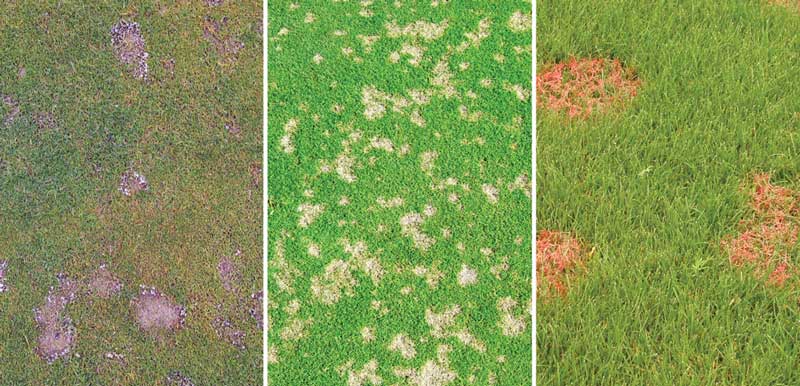Our local climate conditions can sometimes provide the ideal breeding ground for particular lawn diseases. Generally, these diseases develop due to excessive shade, compacted soil, poor drainage, and lack of sufficient lawn nutrition. In winter, some of these problems worsened due to shorter daylight hours and fungal disease issues can quickly develop.
While you can’t control the weather, you can recognise the local conditions that can lead to problems, learn how to identify lawn diseases, and take appropriate action.
Some of the most common lawn diseases to look out for are discussed below. As always – contact the team at Daleys Turf if you have any questions or need some advice on your lawn.

Winter fusarium (Microdochium nivale)
Winter Fusarium is a type of fungus on your lawn that appears in a small circular, water-soaked patch less than 5cm in diameter. They sometimes continue to enlarge to 20cm if left untreated. Smoke like rings can also occur on the outer edge of the patch with a water-soaked appearance
Winter Fusarium change in colour from orange-brown to dark brown and finally to a light gray. Soil high in nitrogen but low in phosphorous and potassium can present perfect conditions for the growth of Winter Fusarium. Lawn areas with slow growing conditions and heavy thatch development also favour it’s growth.
Treatment:
Remove thatch in spring and use a balanced, high nitrogen fertiliser. Water in the mornings only and make sure that you aerate the soil. If required, treat the areas Treat with a fungicide like Mancozeb or Zaleton Fungicide.
Lawn Rust
Lawn rust is a fungal disease that occurs on your lawn when it’s growth is slowed and get worse as grass stays wet for longer. It appears in late summer or early autumn and during periods of dry weather or when the grass is low on nitrogen. Lawn Rust weakens the strength of your lawn and makes it more susceptible to other diseases and turf problems.
Lawn Rust can be identified by pulling a couple of blades out of the lawn – they will be coated with orange-red to yellowish brown dust or spores that can be rubbed off the grass blades with your fingers.
Treatment:
Fertiliser, thatch removal, aeration and general lawn maintenance generally keeps this disease under control.
Dollar Spot
Dollar Spot is a very common fungal disease and, in some areas, can develop at any time during the year. As its name suggests, the appearance of this disease is usually identifiable as dollar sized spots of discoloured grass appearing within your lawn.
Discoloured leaves will have straw coloured lesions with red/brown edges to them. If left to spread the spots will get larger and form bigger patches of affected grass. Dollar Spot is often due to inadequate nutrients in the soil or poor lawn care, such as watering at night, thatch build-up, soil compaction and poor drainage.
Treatment:
The best approach to control Dollar Spot in your lawn is through the use of a high nitrogen fertiliser and the removal of thatch layers in the spring. Again – good lawn maitenance will help control the disease. If required, treat the areas Treat with a fungicide like Mancozeb or Zaleton Fungicide.
Red Thred
Red Thread is a fungal disease found on lawns and is circular or irregularly shaped with small to large patches (5 to 15cm) in diameter. The first signs of this disease are small yellow/brown patches with small red threads or needles and pink soft mycelium fluff. The disease spreads to form larger areas. Small soaked patches in spring are another symptom. This disease is common in lawns low in nitrogen. Red Thread thrives in temperatures between 17°C to 29°C which are also humid.
Treatment:
Use a nitrogen-based fungicide with a systemic component like Zaleton Fungicide.

This Post Has 0 Comments